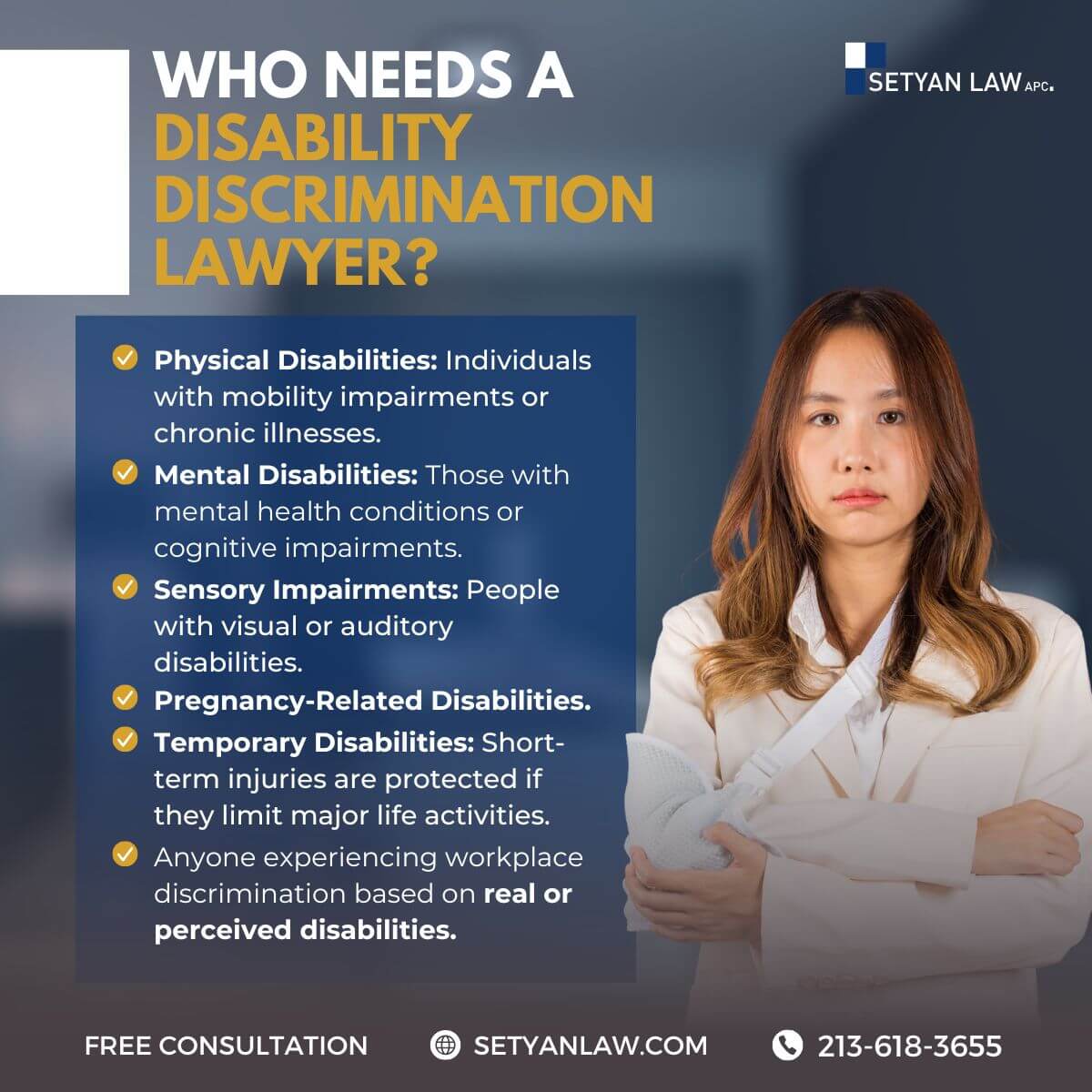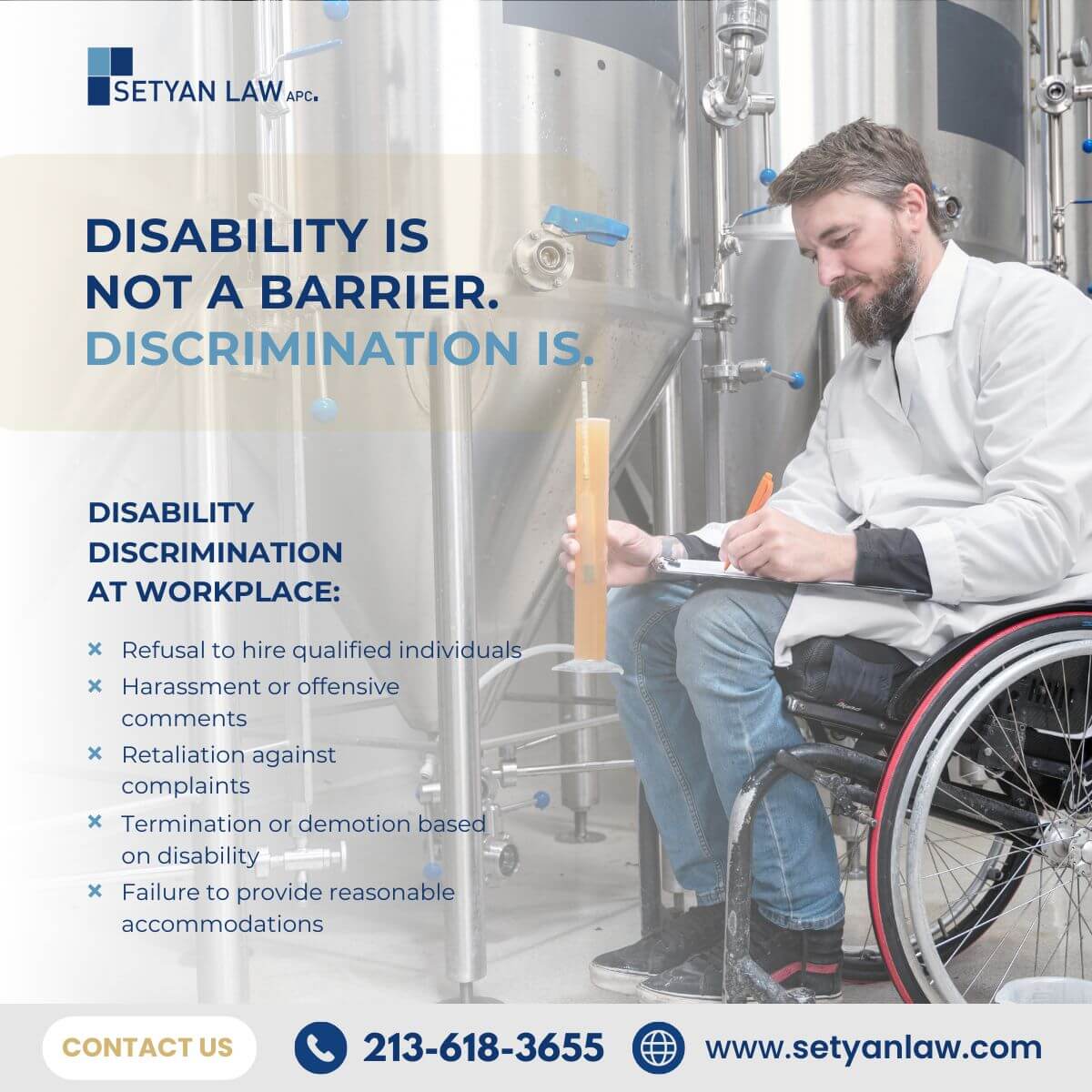Updated November 21, 2025
How to Prove Workplace Disability Discrimination: A Legal Guide
Disability workplace discrimination affects approximately 1 in 4 American workers with disabilities, with thousands of claims filed in California each year. Unfortunately, proving this discrimination can feel overwhelming, especially when you're already dealing with the stress of unfair treatment at work.
Facing discrimination because of your disability doesn't just impact your career—it affects your financial stability, emotional wellbeing, and fundamental rights as a California employee. However, California offers some of the strongest workplace protections in the nation through the Fair Employment and Housing Act (FEHA), which provides broader coverage than federal laws.
To successfully prove disability discrimination, you need to understand what qualifies as a disability under California law, gather compelling evidence, and navigate the proper legal channels. Additionally, knowing how to properly request accommodations and document your employer's responses can significantly strengthen your case.
This guide will walk you through the essential steps to prove workplace disability discrimination in California, from identifying qualifying disabilities to filing a formal complaint with the appropriate agencies. Whether you've been denied reasonable accommodations, passed over for promotion, or wrongfully terminated, understanding these legal frameworks is your first step toward seeking justice.
Understanding Disability Discrimination in California
California stands at the forefront of workplace disability protections through its Fair Employment and Housing Act (FEHA), which offers substantially stronger safeguards than federal laws. Understanding these protections is crucial for anyone facing potential disability workplace discrimination.
What counts as a disability under FEHA
The Fair Employment and Housing Act defines disability broadly, requiring only that a condition "limits" (not "substantially limits") a major life activity. This distinction creates wider coverage for California workers compared to federal standards [1].
FEHA recognizes two primary categories:
Physical disabilities include any physiological disease, disorder, condition, cosmetic disfigurement, or anatomical loss affecting one or more body systems. This encompasses conditions affecting neurological, immunological, musculoskeletal, respiratory, cardiovascular, reproductive, digestive, and other systems [2].
Mental disabilities include any mental or psychological disorder that limits a major life activity, such as emotional illness, cognitive disability, autism spectrum disorders, schizophrenia, clinical depression, bipolar disorder, and post-traumatic stress disorder [2].
Furthermore, FEHA explicitly protects specific conditions including HIV/AIDS, cancer, hepatitis, epilepsy, diabetes, multiple sclerosis, and heart disease [1].
An important distinction: when determining if someone has a disability, employers cannot consider mitigating measures such as medication or assistive devices unless these measures themselves limit major life activities [3].
Types of discrimination covered
Disability discrimination occurs in multiple forms under California law:
Employment decisions – Refusing to hire, select for training, or employ a qualified individual; discriminating in compensation, terms, or privileges of employment [4].
Harassment – Unwelcome conduct based on disability.
Retaliation – Taking adverse action against someone who asserts their rights or requests accommodations.
Failure to accommodate – Not providing reasonable accommodations unless doing so would cause undue hardship.
According to a report from the California Department of Fair Employment and Housing, disability discrimination and retaliation were the most frequently reported workplace discrimination types between 2011 and 2014 [5].
Difference between actual and perceived disabilities
FEHA protects individuals with both actual disabilities and those merely perceived to have disabilities [6]. This distinction creates three protected categories:
Actual disability – A person who genuinely has a physical or mental condition limiting a major life activity.
Record or history of disability – Someone who previously had a disability or was misclassified as having one [2].
Perceived disability – Being regarded, perceived, or treated as having a disability even when none exists [2]. For instance, if an employer discriminates against someone they believe has a speech impediment after oral surgery, this constitutes illegal discrimination despite being mistaken about the condition [7].
California law likewise protects those with "perceived potential disabilities" – conditions that currently have no disabling effect but might become disabling in the future [2].
Consequently, to pursue a disability discrimination case in California, you don't necessarily need to have an actual disability – experiencing discrimination based on a perceived condition provides sufficient grounds for legal action.
Call Setyan Law at (213)-618-3655 to schedule a free consultation.
Key Legal Elements You Must Prove
Proving workplace disability discrimination requires establishing specific legal elements to build a successful case. While California offers strong protections, you still need to systematically demonstrate four critical components to prevail in a disability discrimination claim.
You have a qualifying disability
Initially, you must establish that you have a condition meeting California's legal definition of disability. Under FEHA, the threshold is more accessible than federal standards, requiring only that your condition "limits" rather than "substantially limits" a major life activity. This means your condition simply needs to make a major life activity "difficult" for you.
You can qualify through:
- An actual physical or mental impairment limiting major life activities
- A record or history of such disability known to your employer
- Being perceived as having a disability (even if you don't actually have one)
Notably, California protects those with perceived potential disabilities – conditions without current disabling effects but that might become disabling later. FEHA also explicitly covers medical conditions related to cancer diagnosis or genetic characteristics.
You are qualified for the job
Second, you must demonstrate you're qualified for the position and can perform essential job functions with or without reasonable accommodations. This element focuses on your capabilities rather than limitations.
To prove this element, gather:
- Performance evaluations showing satisfactory work
- Qualifications matching job requirements
- Evidence showing you can perform essential functions when provided appropriate accommodations
The burden rests on you to prove you could do the job if properly accommodated. Employers often dispute this element, arguing accommodations would impose "undue hardship" on their operations.
You faced an adverse employment action
Third, you must establish that you experienced a negative employment action. These actions generally affect the terms, conditions, or privileges of employment in meaningful ways.
Common adverse actions include:
- Termination or forced resignation
- Demotion or reduction in responsibilities
- Denial of promotion or advancement
- Significant change in benefits or compensation
- Transfer to less desirable position
- Exclusion from training opportunities
Courts evaluate whether the action would deter a reasonable person from asserting their rights. Minor annoyances or slight changes to job duties typically don't qualify as adverse actions.
Your disability was a motivating factor
Fourth, you must prove a causal connection between your disability and the adverse action. California applies a "motivating factor" standard, meaning your disability need not be the only reason for the negative action – just one substantial factor in the decision.
This differs from the stricter "but-for" causation standard sometimes applied in federal courts. In California, even if your employer had legitimate reasons for their action, they can still be liable if disability discrimination played a meaningful role.
Evidence that may help establish this connection includes:
- Timing (adverse action shortly following disability disclosure or accommodation request)
- Inconsistent application of policies compared to non-disabled employees
- Direct statements or comments revealing bias against your disability
- Pattern of discriminatory treatment toward disabled employees
- Suspicious or shifting explanations for the employer's actions
This causal connection often proves most challenging to establish since employers rarely admit discriminatory intent openly.
Gathering the Right Evidence
Building a strong disability discrimination case hinges on collecting compelling evidence. Thorough documentation creates a foundation that employers find difficult to dispute and gives investigators or attorneys clear insight into your situation.
Medical documentation from your provider
Medical documentation forms the cornerstone of disability discrimination claims. These records must clearly establish your condition's nature, severity, and duration, plus explain how it limits your activities. Effective medical documentation should:
- Describe the impairment and its impact on your ability to perform job functions
- Substantiate why specific accommodations are necessary
- Provide expert opinion about your capabilities with proper accommodations
Remember, documentation can come from various health professionals, not exclusively medical doctors. Physical therapists, psychologists, occupational therapists, and other specialists can provide valid documentation. Moreover, employers cannot request your complete medical records, as these likely contain information unrelated to your accommodation needs.
Employment records and performance reviews
Employment records offer crucial evidence of your qualifications and treatment compared to non-disabled colleagues. Performance evaluations can reveal telling patterns – particularly those showing positive reviews before disability disclosure followed by negative assessments afterward. These records demonstrate your ability to perform essential job functions over time.
Pay attention to sudden shifts in evaluation tone or content after requesting accommodations. Courts have noted that withholding honest feedback from disabled employees (out of misplaced sympathy) actually constitutes discrimination itself, as it denies opportunities for improvement afforded to others.
Emails and written communication with employer
Written communications create a timeline of your disability disclosure, accommodation requests, and your employer's responses. Save all emails regarding:
- Formal accommodation requests
- The interactive process discussions
- HR responses or lack thereof
- Any communications showing delays or resistance
Forward work emails to your personal account when appropriate (being mindful of company policies). These communications often reveal direct or indirect bias, or document an employer's failure to engage in good faith during the interactive process.
Witness statements from coworkers
Third-party perspectives from colleagues provide independent validation of your experience. Coworkers can corroborate your account of events, confirm discriminatory comments or treatment, and describe workplace culture toward employees with disabilities.
Witness testimony becomes particularly valuable when direct evidence is unavailable. Statements from impartial witnesses delivering fact-based accounts carry significant weight. Ask witnesses to document their observations immediately after incidents occur, capturing specific phrases, dates, and circumstances while memories remain fresh.
Throughout your case, maintain meticulous organization of all evidence. This comprehensive approach strengthens your position and demonstrates your commitment to resolving the matter fairly.
It’s always best to consult a qualified Medical Condition Discrimination Attorney regarding your case before you file. Employment law has many pitfalls and an attorney can help you navigate past them safely. Sam Setyan will review your grievance, tell you your options, and guide you to the most favorable outcome possible. It’s your call.
Call 213-618-3655 for a free consultation.
Requesting Accommodations and Engaging in the Process
Properly requesting workplace accommodations constitutes a crucial step in protecting your rights under California disability law. Understanding the formal process not only helps secure necessary adjustments but also establishes documentation that may prove vital if discrimination occurs.
How to formally request accommodations
Initiating an accommodation request requires clear communication with your employer. Although California law doesn't mandate a specific form, your request should:
- Clearly state you have a disability requiring accommodation
- Explain how your condition affects job performance
- Specify which accommodations would help you perform essential functions
- Document the conversation or request in writing whenever possible
Although verbal requests are legally valid, written requests create a documented timeline of your efforts. The California Civil Rights Department offers a sample "Request for Reasonable Accommodation" form that includes spaces for describing your limitations without revealing your diagnosis.
Remember that employers can request verification if your disability isn't obvious, yet they cannot demand your complete medical history or ask about underlying medical causes.
What is the interactive process
The interactive process refers to the legally required dialog between you and your employer to identify effective accommodations. In fact, California employers with five or more employees must initiate this process whenever:
- You request an accommodation
- They observe potential need through a third party
- You exhaust leave benefits but still require accommodation
This collaborative discussion must occur in "good faith" – meaning both parties participate meaningfully toward finding solutions. Your employer might analyze essential job functions, consult experts, or suggest alternative accommodations.
Throughout this process, you must cooperate by providing reasonable medical documentation when requested and participating in accommodation discussions. Neither party can unilaterally impose decisions; the process should be genuinely interactive.
What to do if your request is denied
Upon denial of your accommodation request, first ask for the specific reason. Employers typically deny requests because they:
- Need additional medical documentation
- Consider the requested accommodation unreasonable
- Believe it would create "undue hardship"
- Think it would eliminate essential job functions
Next, determine if appealing internally might resolve the issue. Some employers have formal appeal processes through HR or accommodation committees.
In situations where internal resolution fails, you may file a complaint with the California Civil Rights Department (formerly DFEH) or the federal Equal Employment Opportunity Commission. Importantly, California law specifically prohibits retaliation against employees for requesting accommodations, regardless of whether the request was granted.
Understanding this process thoroughly helps establish a strong foundation for potential disability discrimination claims.
Call Setyan Law at (213)-618-3655 to schedule a free consultation.
Filing a Complaint and Taking Legal Action
After exhausting internal remedies, pursuing formal legal action becomes your next step in addressing disability workplace discrimination. California offers robust protection through established legal channels.
How to file with DFEH or EEOC
The California Civil Rights Department (CRD, formerly DFEH) and the Equal Employment Opportunity Commission (EEOC) handle discrimination complaints through a work-sharing agreement. Filing with one agency automatically cross-files with the other, eliminating duplicate submissions.
The fastest method is filing online through CRD's California Civil Rights System (CCRS) portal. This approach offers several benefits:
- Self-service appointment scheduling
- Document uploading capabilities
- Ability to pause and resume your filing process
Alternatively, you can submit complaints via mail, email, or phone by calling 800-884-1684. For those preferring in-person assistance, CRD maintains several office locations throughout California.
Deadlines and timelines to know
Timing is crucial when filing discrimination complaints. Under California law, you must file with the CRD within three years of the discriminatory act. This timeframe represents a significant extension from the previous one-year limit.
For EEOC filings, you have 300 days (approximately 10 months) from the date of discrimination. Nevertheless, it's advisable to file as soon as possible rather than approaching deadlines.
Be mindful that after receiving a Right-to-Sue notice, you have just one year to file a lawsuit in California state court, creating a separate critical deadline.
What happens after you file a complaint
Once submitted, your complaint undergoes an initial review to determine if it falls under CRD jurisdiction. Subsequently, the agency will:
- Notify your employer about the complaint within 10 days
- Potentially offer voluntary mediation as an alternative resolution path
- Conduct an investigation if mediation is declined or unsuccessful
- Issue a Right-to-Sue notice if the investigation doesn't resolve the matter
Throughout this process, investigators may request documents, conduct interviews, and gather evidence from both parties. The investigation timeline varies but typically takes approximately 10 months for EEOC cases, though mediation can resolve matters in under 3 months.
Indeed, if discrimination is substantiated, agencies may attempt to secure voluntary settlements before proceeding to litigation.
Conclusion
Proving workplace disability discrimination undoubtedly presents challenges, yet California workers benefit from some of the strongest legal protections in the nation. The Fair Employment and Housing Act offers broader coverage than federal standards, recognizing both actual and perceived disabilities while protecting workers against various discriminatory practices.
Remember that successful disability discrimination claims require establishing four critical elements: having a qualifying disability, demonstrating job qualification, experiencing an adverse employment action, and proving your disability factored into that action. Therefore, maintaining detailed documentation throughout your employment becomes essential for building a compelling case.
Additionally, properly requesting accommodations and actively participating in the interactive process strengthens your position. Employers must engage in good-faith discussions about reasonable accommodations, and their failure to do so can itself constitute discrimination under California law.
Should internal resolution attempts fail, filing a complaint with the California Civil Rights Department offers a formal pathway to address discrimination. Although this process takes time, understanding the deadlines and required documentation helps navigate this challenging situation effectively.
Most importantly, know that you deserve equal treatment and opportunities regardless of disability status. California law stands firmly on the side of workers facing discrimination, providing meaningful recourse against unfair treatment. By understanding your rights, gathering appropriate evidence, and following proper procedures, you can effectively combat workplace disability discrimination and protect your career and wellbeing.
References
[1] – https://calcivilrights.ca.gov/wp-content/uploads/sites/32/2022/12/Employment-Discrimination-Based-on-Disability_ENG.pdf
[2] – https://govt.westlaw.com/calregs/Document/I69CD2E735A0A11EC8227000D3A7C4BC3?viewType=FullText&originationContext=documenttoc&transitionType=CategoryPageItem&contextData=(sc.Default)
[3] – https://www.seq.org/documents/HR%20General/Forms/Fair-Employment-and-Housing-Act-Booklet.pdf
[4] – https://www.blairramirezlaw.com/disability-discrimination-in-california
[5] – https://www.chwilliamslaw.com/blog/what-is-disability-discrimination-in-california/
[6] – https://calcivilrights.ca.gov/peoplewithdisabilities/
[7] – https://eldessoukylaw.com/blog/how-to-prove-disability-discrimination/
Call Setyan Law at (213)-618-3655 to schedule a free consultation.









